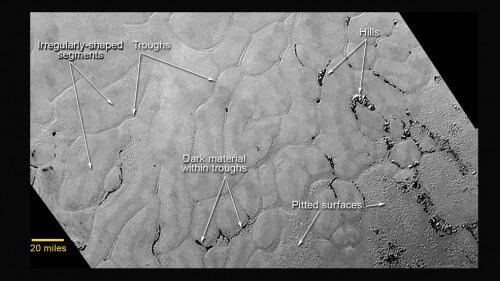The latest photographs from the New Horizons spacecraft show a wide area that has been devoid of craters for no more than 100 million years and may still be geologically active. The area is characterized by an area of cracks and coins with an irregular shape with an average diameter of 20 km, delimited by a kind of troughs

In the center of the image, to the left of Pluto's huge route that resembles a heart shape, lies the Tombo area (named after Pluto's discoverer). It is a vast craterless plain that appears to be at most a hundred million years old and may still be shaped by geological processes. This icy region north of Pluto's ice mountains has been named the Sputnik Plain in honor of the first artificial satellite. The surface appears divided into irregular shaped segments surrounded by narrow rings. In addition, there are groups of mounds and fields of small pits in this area. This image was taken by the LORRI camera on July 14 from a distance of 77,000 kilometers. Details smaller than a kilometer can be seen. Some of my areas look raw due to the image compression. Photo: NASA / JHUAPL / SwRI
The latest photographs from the New Horizons spacecraft show a wide area that has been devoid of craters for no more than 100 million years and may still be geologically active. The frozen area is north of the Ice Mountain chain, to the left of the mountain formation. In the meantime, this area is known informally as the Tombaugh Regio after Clyde Tombaugh, the discoverer of the planet Pluto in 1930.
"It is very difficult to explain the nature of this terrain," says Jeff Moore, head of the geology, geophysics and imaging team for the New Horizons spacecraft at NASA's Ames Center in California. "The discovery of very young, crater-free plains on Pluto surpasses anything we thought before the transit."
The impressive ice plains, reminiscent of frozen mud full of cracks on the Earth, were called "Sputnik Plain" after the Earth's first artificial satellite. It is characterized by an area of cracks and coins with an irregular shape with an average diameter of 20 km, delimited by a kind of troughs (plural of trough). Some of these troughs contain dark materials while others can be identified as a mass of hills rising out of the nearby plains. They seem to have been etched by fields of small pits that may have been created by the takeoff process - on Earth only dry ice (carbon dioxide) behaves this way.
Scientists have two possible theories as to how these segments formed. The irregular shape probably originates from the contraction of materials on the surface, similar to what happens when mud dries. Alternatively, they may be the product of convection similar to a lava eruption. On Pluto, convection may occur within the surface layer made of frozen carbon monoxide, methane, or nitrogen fueled by a small warming of Pluto's interior.
The ice plains also contain lines that are several kilometers long. These lines appear to be arranged in the same direction and may have been created by wind action on the frozen plains.
This configuration, also known as "the heart within the heart" was photographed when New Horizons was 77 thousand km from Pluto and you can see formations that are a kilometer or more wide. Mission scientists will learn more about these mysterious planes when high-resolution images and stereoscopic images arrive that New Horizons will retrieve from the digital records and transmit to Earth over the next year.
For information on the NASA website
More of the topic in Hayadan:

2 תגובות
The image resembles a brain